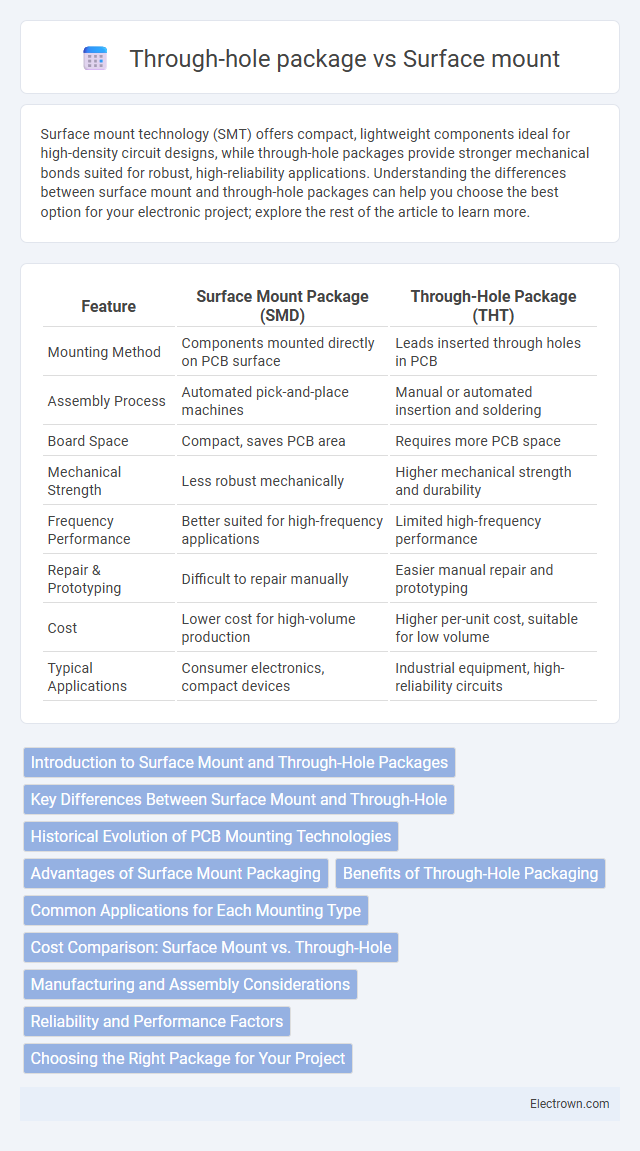Surface mount technology (SMT) offers compact, lightweight components ideal for high-density circuit designs, while through-hole packages provide stronger mechanical bonds suited for robust, high-reliability applications. Understanding the differences between surface mount and through-hole packages can help you choose the best option for your electronic project; explore the rest of the article to learn more.
Table of Comparison
| Feature | Surface Mount Package (SMD) | Through-Hole Package (THT) |
|---|---|---|
| Mounting Method | Components mounted directly on PCB surface | Leads inserted through holes in PCB |
| Assembly Process | Automated pick-and-place machines | Manual or automated insertion and soldering |
| Board Space | Compact, saves PCB area | Requires more PCB space |
| Mechanical Strength | Less robust mechanically | Higher mechanical strength and durability |
| Frequency Performance | Better suited for high-frequency applications | Limited high-frequency performance |
| Repair & Prototyping | Difficult to repair manually | Easier manual repair and prototyping |
| Cost | Lower cost for high-volume production | Higher per-unit cost, suitable for low volume |
| Typical Applications | Consumer electronics, compact devices | Industrial equipment, high-reliability circuits |
Introduction to Surface Mount and Through-Hole Packages
Surface mount technology (SMT) involves mounting electronic components directly onto the surface of printed circuit boards, enabling higher component density and automated assembly processes. Through-hole technology uses leads inserted into drilled holes on the PCB, providing strong mechanical bonds ideal for components subjected to mechanical stress. SMT components are smaller and support higher circuit complexity, while through-hole packages offer enhanced durability and ease of prototyping in electronic designs.
Key Differences Between Surface Mount and Through-Hole
Surface mount packages are mounted directly onto the surface of printed circuit boards (PCBs), enabling higher circuit density and automated assembly, while through-hole packages require component leads to pass through holes in the PCB for soldering, providing stronger mechanical bonds. Surface mount technology (SMT) supports smaller, lighter components ideal for compact, high-speed electronics, whereas through-hole technology (THT) offers better durability and is preferred in applications subject to mechanical stress or high heat. You should choose between SMT and THT based on your design's complexity, space constraints, and environmental factors.
Historical Evolution of PCB Mounting Technologies
Surface mount technology (SMT) emerged in the 1960s as a response to the demand for smaller, faster, and more efficient electronic devices, replacing the older through-hole technology that dominated since the 1940s. Through-hole mounting uses leads inserted into drilled holes and soldered on the opposite side, offering strong mechanical bonds but limited component density. SMT allows components to be directly mounted onto the PCB surface, enabling higher component density, reduced manufacturing cost, and enhanced electrical performance, driving the evolution of modern electronics manufacturing.
Advantages of Surface Mount Packaging
Surface mount packaging offers significant advantages including higher component density and smaller board size due to the absence of lead wires passing through the PCB, enabling more compact and lightweight electronic devices. The automated assembly process reduces manufacturing time and cost while improving reliability by minimizing solder joint defects. Enhanced electrical performance and improved heat dissipation are also key benefits that make surface mount technology (SMT) the preferred choice in modern electronics manufacturing.
Benefits of Through-Hole Packaging
Through-hole packaging offers superior mechanical strength due to leads passing through the PCB, ensuring reliable connections in high-stress environments. This technology simplifies prototyping and manual soldering, making it ideal for low-volume or repairable electronic assemblies. Through-hole components also provide enhanced durability and better thermal dissipation compared to surface mount devices, benefiting applications requiring robust performance.
Common Applications for Each Mounting Type
Surface mount technology (SMT) is widely used in compact consumer electronics, such as smartphones, laptops, and wearable devices, where space-saving and high-density circuit designs are crucial. Through-hole packages excel in applications requiring strong mechanical bonds and durability, like automotive electronics, industrial equipment, and military hardware, due to their robust solder connections. Your choice between SMT and through-hole packaging depends on factors like device size constraints, environmental conditions, and mechanical stress tolerance.
Cost Comparison: Surface Mount vs. Through-Hole
Surface mount technology (SMT) generally offers lower manufacturing costs due to smaller component sizes and automated placement, which enhances production speed and reduces labor expenses. Through-hole components, while more expensive to assemble because of manual insertion and additional drilling processes, provide superior mechanical strength for certain applications. Your choice between surface mount and through-hole should consider volume, budget constraints, and the specific durability requirements of your project.
Manufacturing and Assembly Considerations
Surface mount technology (SMT) enables faster, more automated assembly with higher component density compared to through-hole packages, which require manual insertion and wave soldering, increasing production time and cost. SMT components reduce board size and enable double-sided placement, enhancing manufacturing efficiency and scalability for mass production. Your choice impacts assembly line speed, labor costs, and overall design complexity in electronics manufacturing.
Reliability and Performance Factors
Surface mount technology (SMT) offers higher reliability in high-frequency applications due to shorter lead lengths and lower parasitic inductance compared to through-hole packages. Through-hole components provide stronger mechanical bonds suitable for high-stress environments, enhancing durability under physical strain or thermal cycling. Your choice depends on whether electrical performance or mechanical robustness is prioritized in the design specifications.
Choosing the Right Package for Your Project
Choosing the right package for your project depends on factors like component size, durability, and assembly method. Surface mount devices (SMD) offer compact design and automated assembly benefits, ideal for high-density and mass production. Through-hole packages provide stronger mechanical bonds, suitable for components subjected to physical stress or prototyping where manual soldering is common.
Surface mount vs Through-hole package Infographic

 electrown.com
electrown.com